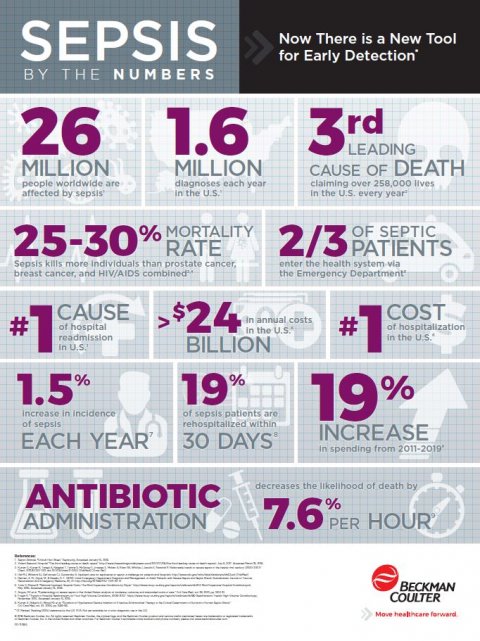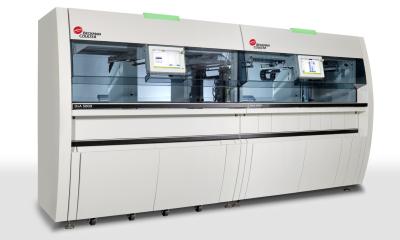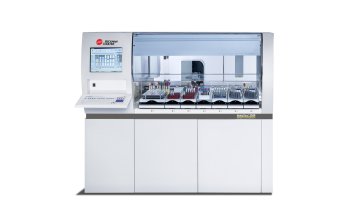News • New hematologic biomarker
FDA clearance for early sepsis indicator
A major milestone on its strategic mission to lead in sepsis diagnostics, Beckman Coulter announced that its Early Sepsis Indicator has received 510(k) clearance from the U.S. Food and Drug Administration (FDA).
Source: Unsplash/Cassi Josh
Sepsis is a global healthcare crisis that affects more than 30 million people worldwide. The Early Sepsis Indicator is a first-of-its-kind, hematology-based cellular biomarker that is designed to help emergency department physicians identify patients with sepsis or at increased risk of developing sepsis. As part of the pivotal clinical trial for the Early Sepsis Indicator, findings showed that Beckman Coulter’s unique monocyte distribution width (MDW) biomarker best discriminated sepsis from all other conditions when combined with the current standard of care. Dr. Derek Angus, chair of the Department of Critical Care Medicine at UPMC (University of Pittsburgh Medical Center), a collaborator in the study, said that the Early Sepsis Indicator is “a novel feature in that it is exploiting the way in which white blood cell counts are already calculated.”

Other clinical collaborators in the study commented: “Sepsis is a leading cause of hospital mortality, and our study findings indicate this simple biomarker test improves the detection of sepsis at an early stage when it is most responsive to treatment. It’s an important breakthrough and it’ll likely make a big impact in the care of sepsis, as it is easy to implement and works best when combined with other widely available sepsis diagnostic tools at the time of the initial hospital encounter.” - Elliott Crouser, MD, principal investigator in the clinical trial, The Ohio State University Wexner Medical Center.
“Early antibiotic treatment of sepsis and septic shock leads to improved patient survival. Beckman Coulter’s Early Sepsis Indicator helps to identify sepsis patients with proven accuracy, providing the opportunity for clinicians to institute treatment when antibiotics are most effective.” – Joseph E. Parrillo, M.D., chair, Heart and Vascular Hospital at Hackensack Meridian Health, Hackensack University Medical Center
The Early Sepsis Indicator is automatically reported as part of a routine complete blood count (CBC) with differential for adult emergency department patients. A positive Early Sepsis Indicator result signals a higher probability of sepsis, enabling physicians to initiate lifesaving treatments faster. Conversely, a negative reading indicates a lower probability of sepsis. Compared to reviewing white blood cell count alone, the Early Sepsis Indicator strengthens a clinician’s suspicion of sepsis by 43% and, together with clinical signs and symptoms, improves their confidence in helping to rule out sepsis by 63%. “The devastating clinical consequences and financial burden of sepsis are now recognized worldwide,” said Peter Soltani, Ph.D., senior vice president and general manager of the hematology business at Beckman Coulter. “We are privileged to provide emergency department personnel and clinical laboratorians the tools and information they need to more efficiently recognize sepsis and make treatment decisions as quickly as possible. Knowing sooner and acting faster is the name of the game in the fight against sepsis, and we believe that the Early Sepsis Indicator has the potential to revolutionize the clinical approach to sepsis triage and diagnosis.”
Recommended article

News • Research
Path to deadly sepsis varies by bacterial infection
Sepsis remains a common and deadly condition that occurs when the body reacts to an infection in the bloodstream. Scientists know little about the early stages of the condition; however, physicians must act fast. Every hour that passes without one or more of the few treatments available increases the risk of death.
The Early Sepsis Indicator can be used in conjunction with Beckman Coulter’s patented Multidiscipline Reflex Rules in REMISOL Advance middleware. These reflex rules can create customized, automated reflex panels of Beckman Coulter’s industry-leading portfolio of in vitro diagnostic tests in the current sepsis identification and management care pathway across multiple disciplines, including hematology, clinical chemistry, immunoassay, microbiology and urinalysis. The Early Sepsis Indicator is also part of Beckman Coulter’s clinically impactful menu that matters which address the most prevalent and costly health conditions.
Source: Beckman Coulter
19.04.2019











